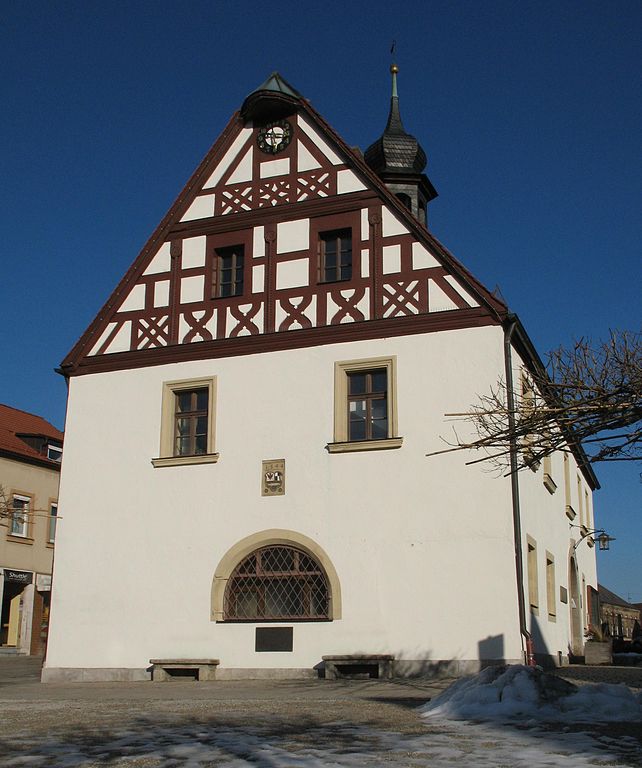



WELCOME Introduction History Exhibit Displays Visit Pegnitz' Jewish Residents Jewish Committee Property Pflaum Letter ♯♯♯♯♯♯♯♯♯♯♯♯♯♯♯♯

With the liberation of the concentration camps and the end of the Second World War in May 1945, the path to a new life began for the few Jewish survivors of the Holocaust (Shoah). In the Jewish Displaced Person (DP) camps, many began to come to terms with their experiences, trauma, and losses. During the Holocaust, six million Jewish women, men, and children were murdered. Only a few survived the concentration camps or were illegally in hiding. They formed a minority of the seven million people who received the status of Displaced Persons (DPs). DPs were people who had been abducted or expelled from their homes as a direct or indirect result of the war.
The Allies faced the difficult task of caring for the malnourished and often seriously ill. After all, returning to their home countries was out of the question in the first few months after the war. The Allies first grouped the displaced persons into national groups, such as Poles, Hungarians, and Czechs. Later they were to be repatriated, i.e., brought back to their countries of origin. However, Jewish survivors did not form a national group; they developed their own identity as Jews, which was also shaped by the shared experience of persecution. Since the situation of the Jewish DPs differed from that of all other groups as a result of the consequences of the Shoah, special DP camps for Jewish DPs were set up in the three western zones of occupation from autumn 1945. This significantly improved the situation of the Jewish DPs. No DP camps were set up in the Soviet occupation zone.
Many of the Jewish DPs had not only lost their homes, but also lost their relatives, friends, and neighbors. It was impossible to return to their old lives. For many Jewish survivors of the Shoah, the DP camps became the first port of call on the way back to life. Social, cultural, political, and religious life slowly began to unfold again. There was mourning, and new relationships were made. Jewish festivals and holidays were celebrated, marriages were celebrated and children were born.
Life in the community of the DP camps was just an intermediate stop on the way to a new life. People had to make important decisions, e.g., where they wanted to live in the future. Many DPs were waiting for the opportunity to emigrate, typically to the USA or to Palestine / Israel. Dealing with Zionism and the forthcoming founding of the State of Israel was a central theme in many DP camps.
Jewish life in Germany was revived in the DP camps and elsewhere. Some things only developed over time, others should become established. On June 19, 1950, the "Central Council of Jews in Germany" was founded in Frankfurt am Main.
Nuremberg (dpa/lby) - Numerous events will be held in Bavaria in the year after next [2021] to commemorate 1700 years of Jewish life in Germany. The anniversary goes back to the first mention of a Jewish community in Cologne in an edict of the Roman Emperor Constantine in 321. In Bavaria, Jewish life has been documented for 1000 years, said Bavaria's anti-Semitism commissioner Ludwig Spaenle on Friday in Nuremberg at a conference in preparation for the commemorative year "321 - 1700 years of Jewish life in Germany". "But we can assume that Jews lived in what is now Bavaria as early as late antiquity," emphasized Spaenle. The anniversary offers the opportunity to make it clear that Jews have naturally helped to shape and shape everyday life, culture, society and the economy in Germany and Bavaria.
At the conference, cultural advisors from municipalities and Jewish communities, district home caretakers, museum directors, artists and musicians will advise on events in the year of remembrance. "Only education and enlightenment can lead to people not accepting the prejudices, stereotypes, rubbish and madness that coagulates in anti-Semitism," warned Spaenle. According to the Anti-Semitism Commissioner, there are plans to digitize the archives of around 300 former Jewish communities that are located in Israel's national archives and will in future also be available to researchers and interested parties in Bavaria. In addition, the approximately 100 Jewish cemeteries that still exist in Bavaria are to be documented and scientifically processed. In addition, Spaenle would like to prepare biographies of important Jewish personalities with connections to Bavaria - such as the physicist Albert Einstein, FC Bayern President Kurt Landauer, the inventor of jeans Levi Strauss and the mathematician Emmy Noether.
Andrei Kovacs from the board of trustees of the association "1700 Years of Jewish Life in Germany" said the anniversary year was a unique opportunity to overcome anti-Semitism and provide a convincing response to the Halle attack. There, on October 9, a heavily armed right-wing extremist tried to break into a synagogue and killed two people. See Celebrating 1700 Years of Jewish Life In Germany.
==================================================
Below is a slideshow album consisting of
photographs of selected pages from the chapter
Upper Franconia
The Region Between Bayreuth and Pegnitz.
Note: Text is in German.
Click the following photo to begin the slideshow.
Then click the arrows to manually cycle through the images.
Each slide can be enlarged by clicking the image;
to continue with the slideshow,
click back arrow on upper left of screen.